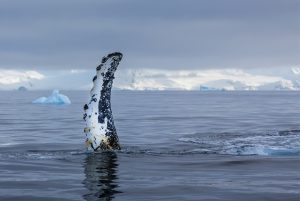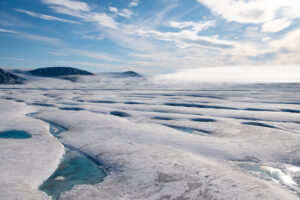For the second winter in a row, a hole roughly the size of Lake Superior has opened up in the sea ice on Antarctica’s Weddell Sea. While that might sound alarming, a University of Toronto Mississauga professor says it presents a perfect opportunity to study how the ocean and atmosphere interact in the southern polar region.
Kent Moore, who teaches in UTM’s Department of Chemical and Physical Sciences, has been collaborating with members of the Southern Ocean Carbon and Climate Observations and Modeling (SOCCOM) research project to understand why these areas of open water — called polynyas — spontaneously appear in mid-winter sea ice, and what they can tell us about how the Southern Ocean might be responding to anthropogenic climate change.
“I’m really interested in understanding how the ocean and the atmosphere transfer heat and energy back and forth, especially at high latitudes where the sea ice kind of complicates things,” he explains.
Polynyas occur regularly at the poles, usually in coastal areas where strong prevailing winds and currents push away the sea ice. (The Canadian Arctic is home to 23 more or less geographically fixed polynyas that provide critical habitat for polar wildlife.) The Weddell Sea polynya is fairly unique and rare in that it forms far offshore, in an area of shallow water called the Maud Rise. It’s thought to be caused by an upwelling of warm water that over time transfers its heat to the atmosphere, cools, and sinks. This cycle continues until warm springtime temperatures melt the rest of the sea ice.
Some researchers believe the polynya may even play a critical role in feeding cold water back into the global ocean conveyor belt. The extremity of winter conditions in the region, however, means there have been few opportunities to observe it directly. The last time the Weddell Sea polynya grew this large, in the mid-1970s, NASA had just launched its first dedicated satellites for monitoring sea ice from space — “We just barely knew it was there,” Moore says.
But over the last few years, SOCCOM has deployed Argo floats in the Weddell Sea to gather data on water temperature, salinity, oxygen content and currents. The floats are programmed to rise to the surface every few days and transmit their data. Normally, they are unable to transmit data during the winter months due to the thickness of the sea ice, but this year, completely by coincidence, a float was able to surface inside the polynya. Moore and his fellow researchers are now excitedly analyzing the data it sent back.
“We now have an opportunity to really understand the dynamics of these polynyas — how they form and how the ocean is responding to the lack of sea ice,” he says.





